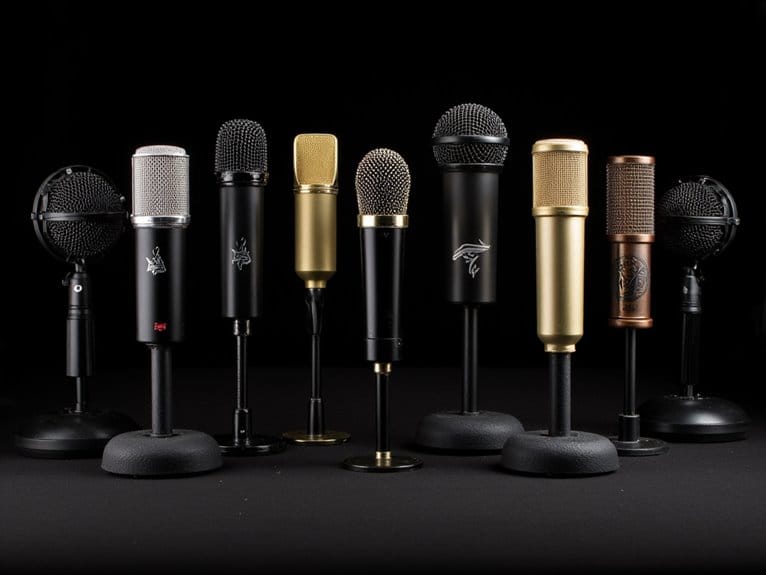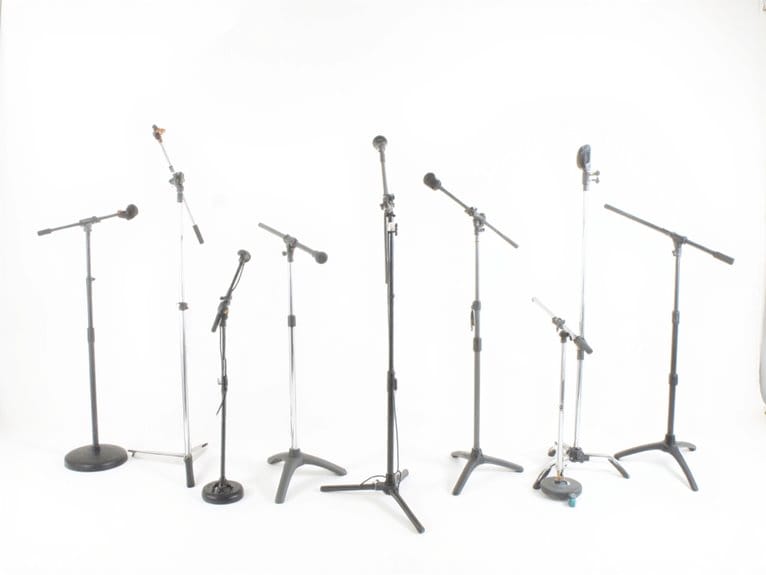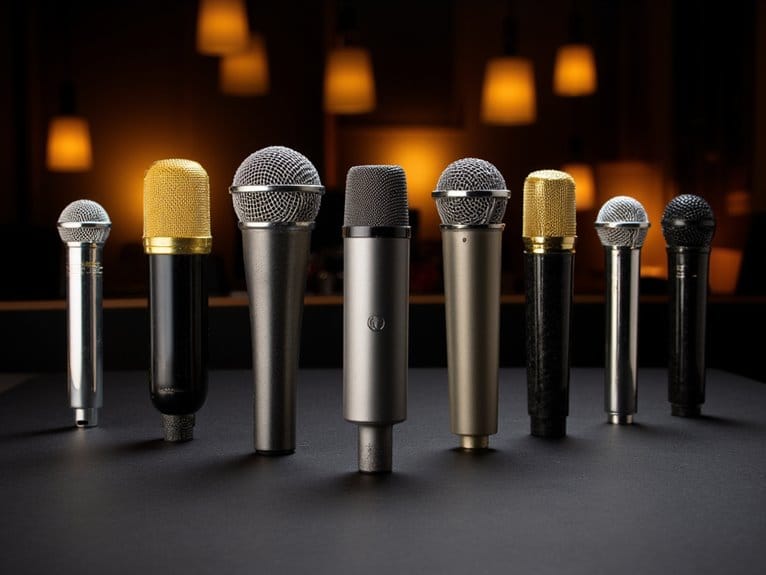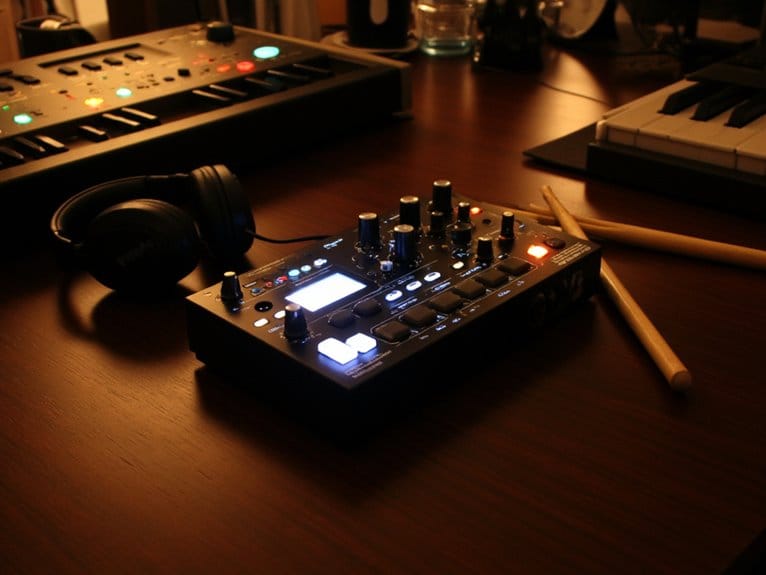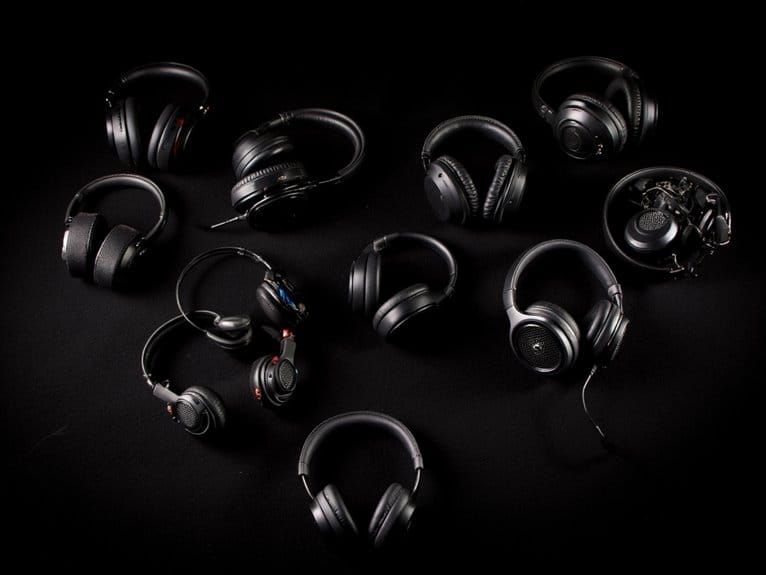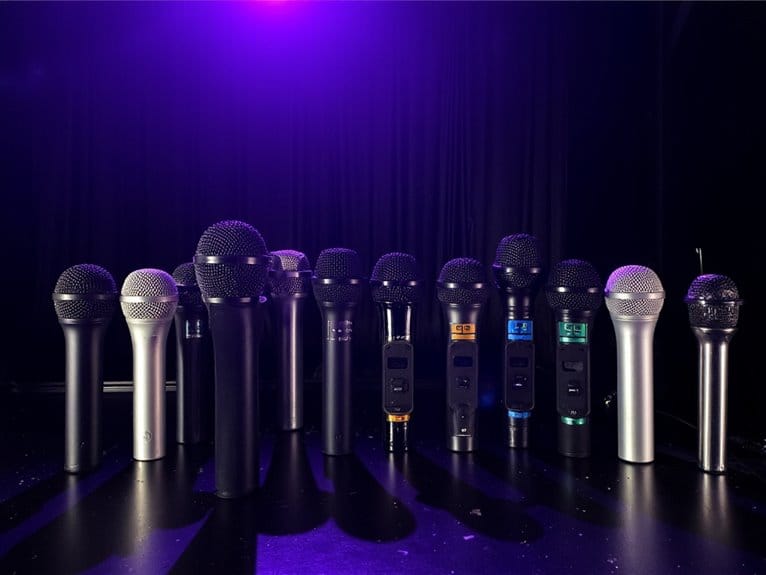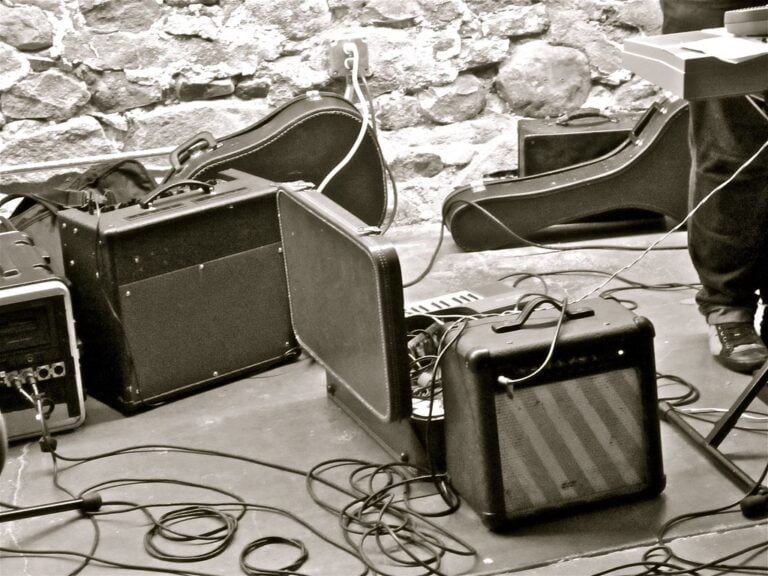10 Best Vocal Microphones
I’ve found the best vocal microphones span from the $20 Amazon Basics Dynamic for casual home recording to professional standards like the Shure SM58, which dominates live performances with its legendary durability and tailored frequency response. For studio work, I recommend condenser mics like the FIFINE T669 kit, while the Shure SM7B excels for broadcasting with superior noise rejection. Budget-conscious podcasters should consider the MV7X’s XLR connectivity, and the JBL wireless system suits events perfectly. Below, I’ll break down each option’s specific strengths.
We are supported by our audience. When you purchase through links on our site, we may earn an affiliate commission, at no extra cost for you. Learn more.
Notable Insights
- Dynamic microphones like the Shure SM58 and BETA 58A excel for live vocals with durability and effective background noise rejection.
- Condenser microphones capture subtle vocal nuances making them ideal for studio recordings and professional sound quality.
- USB microphones offer plug-and-play convenience for beginners, while XLR models provide professional connectivity options.
- Cardioid and supercardioid polar patterns minimize unwanted background noise and focus on the vocalist’s voice direction.
- Budget ranges from $20 entry-level options to $400 professional models, with higher investments delivering superior sound quality and build.
Amazon Basics Dynamic Microphone for Karaoke, Podcasting, Live Performance

When you’re hunting for a budget-friendly microphone that won’t embarrass you during karaoke nights or podcast recordings, the Amazon Basics Dynamic Microphone presents itself as a surprisingly competent performer that punches well above its $20 price point. The cardioid pickup pattern effectively isolates your voice while minimizing background noise, and the zinc die-cast housing with steel mesh head provides durability that’ll withstand enthusiastic performers. You’ll appreciate the included XLR-to-quarter-inch cable and convenient on/off switch, though the plastic clip feels somewhat flimsy compared to the microphone’s solid construction. With 4.4 stars from nearly 3,000 reviews, it’s proven reliable for home recording and live performances.
Best For: Budget-conscious content creators, karaoke enthusiasts, and amateur podcasters who need a reliable microphone for home recording and live performances without breaking the bank.
Pros:
- Excellent value at $20 with solid zinc die-cast construction and steel mesh head that withstands heavy use
- Cardioid pickup pattern effectively isolates vocals while minimizing background noise and feedback
- Includes essential accessories like XLR-to-quarter-inch cable and convenient on/off switch for immediate use
Cons:
- Plastic microphone clip feels flimsy compared to the otherwise solid build quality
- Not suitable for professional studio recording applications due to limited audio fidelity
- No carrying case included for transport and storage protection
Shure SM58 Pro XLR Dynamic Microphone (SM58-LC)

The Shure SM58 Pro XLR Dynamic Microphone stands as the undisputed heavyweight champion of vocal microphones, earning its legendary status through decades of reliable performance in recording studios, concert venues, and home setups worldwide. You’ll experience its tailored frequency response from 50 Hz to 15 kHz, which brightens the midrange frequencies vital for vocal clarity. The cardioid pickup pattern consistently delivers warm, crisp sound while its spherical mesh grille and built-in pop filter minimize background noise effectively. At 310 grams, this tank-like microphone features metal construction that withstands road abuse, though you’ll need a quality audio interface with sufficient gain to access its full potential.
Best For: Vocalists, podcasters, and performers who need a durable, professional-grade microphone for studio recording, live performances, or content creation with existing audio equipment.
Pros:
- Industry-standard vocal microphone with tailored frequency response (50 Hz to 15 kHz) that brightens midrange for exceptional vocal clarity
- Extremely durable metal construction weighing 310 grams with tank-like build quality that withstands heavy road use
- Effective noise reduction through cardioid pickup pattern, spherical mesh grille, and built-in pop filter for consistent warm, crisp sound
Cons:
- Requires quality audio interface with high gain capability rather than direct PC connection for optimal performance
- At 310 grams, the weight may be considered heavy for extended handheld use during long performances
- Limited frequency range compared to condenser microphones, potentially restricting versatility for certain recording applications
FIFINE XLR/USB Gaming Microphone Set (AmpliGame AM8T)

For content creators who need professional audio quality without breaking the bank, the FIFINE XLR/USB Gaming Microphone Set (AmpliGame AM8T) delivers impressive versatility with its dual connectivity options, allowing you to plug directly into your computer via USB or connect to professional audio interfaces through XLR. You’ll appreciate the crystal-clear vocal reproduction across its 50Hz-16kHz frequency range, though I’ve noticed the high frequencies can occasionally sound piercing with certain voice types. The cardioid polar pattern effectively suppresses background noise, while the included boom arm provides convenient positioning despite some users reporting vibration issues that require spring modifications for ideal performance.
Best For: Content creators, streamers, and podcasters seeking professional audio quality on a budget who need flexible connectivity options for both computer and professional audio interface setups.
Pros:
- Dual XLR/USB connectivity provides versatility for direct computer connection or professional audio interface use
- Crystal-clear vocal reproduction with effective cardioid polar pattern that suppresses background noise
- Quick plug-and-play setup with no proprietary software required, plus customizable RGB lighting
Cons:
- High frequencies can sound piercing with certain voice types
- Boom arm may produce vibrations and noise, potentially requiring spring modifications
- XLR cable not included despite advertising XLR connectivity
FIFINE Studio Condenser USB Microphone Kit with Adjustable Boom Arm Stand (T669)

Content creators and podcasters seeking professional-grade audio without breaking the bank will find their perfect match in the FIFINE Studio Condenser USB Microphone Kit (T669), an all-inclusive recording solution that delivers studio-quality sound through its cardioid condenser capsule and impressive 20Hz to 20KHz frequency response. You’ll appreciate the plug-and-play simplicity, requiring zero additional drivers for immediate compatibility with PCs and recording software like OBS or Audacity. The extensive package includes an adjustable boom arm with 180° vertical movement, shock mount, double pop filter, and 8.2-foot USB cable, fundamentally providing everything you need for professional recordings at approximately AU$70-though you’ll sacrifice Xbox and mobile compatibility for this convenience.
Best For: Content creators, podcasters, and streamers who want professional-quality audio recording with a complete accessory kit at an affordable price point for PC-based setups.
Pros:
- Delivers crystal-clear studio-quality sound with wide 20Hz-20KHz frequency response and cardioid condenser capsule
- Complete all-in-one kit includes adjustable boom arm, shock mount, double pop filter, and USB cable for immediate setup
- Plug-and-play compatibility with no drivers needed and excellent value at approximately AU$70
Cons:
- Not compatible with gaming consoles like Xbox or mobile phones, limiting versatility
- Boom arm stability issues and occasional challenges with pop filter adjustments reported by users
- May capture some background noise despite good signal-to-noise ratio specifications
Shure SM58 Pro XLR Dynamic Microphone (SM58-LC)

When you’re searching for a microphone that’ll survive the roughest gigs while delivering consistently clear vocals, the Shure SM58 Pro XLR Dynamic Microphone stands as the undisputed champion that’s earned its legendary status through decades of abuse on stages worldwide. This cardioid dynamic microphone’s tailored frequency response from 50 Hz to 15 kHz brightens midrange frequencies, ensuring your vocals cut through dense mixes with remarkable clarity. The spherical mesh grille and built-in pop filter minimize background noise while its uniform cardioid pattern consistently delivers warm, crisp sound reproduction across various performance environments, making it equally suitable for studio recording and live performances.
Best For: Professional vocalists, podcasters, and live performers who need a reliable, industry-standard microphone that delivers clear vocal reproduction in both studio and stage environments.
Pros:
- Exceptional durability with tank-like construction that withstands heavy road use and abuse
- Tailored frequency response (50 Hz to 15 kHz) with brightened midrange for clear vocal cut-through in dense mixes
- Built-in noise reduction features including spherical mesh grille and pop filter that minimize background noise and handling sounds
Cons:
- Requires high gain from quality preamps for optimal performance, not suitable for direct PC connection
- Limited frequency range (15 kHz upper limit) compared to some condenser microphones
- Heavier weight at 310 grams may cause fatigue during extended handheld use
Shure SM58 Pro XLR Dynamic Microphone with On/Off Switch (SM58S)

The legendary SM58S stands as the industry’s most trusted vocal microphone, earning its reputation through decades of flawless performance in everything from intimate studio sessions to massive concert stages. What sets this version apart from its sibling, the SM58-LC, is the convenient on/off switch that eliminates the need for unplugging during breaks. You’ll appreciate the tailored frequency response spanning 50 Hz to 15 kHz, which brightens midrange frequencies for exceptional vocal clarity. The cardioid polar pattern isolates your voice effectively while the built-in spherical filter minimizes unwanted breath sounds, making it perfect for live performances where ambient noise can be problematic.
Best For: Vocalists, podcasters, and performers who need a reliable, professional-grade microphone with convenient on/off control for live performances, studio recording, and speaking engagements.
Pros:
- Exceptional durability with rugged steel mesh grille construction that withstands heavy use and rough handling
- Tailored frequency response (50 Hz – 15 kHz) with brightened midrange that delivers clear, warm vocal reproduction
- Convenient on/off switch eliminates need to unplug during breaks, plus cardioid pattern effectively isolates vocals from background noise
Cons:
- Requires XLR input and phantom power, making it less suitable for plug-and-play setups with basic devices
- At 10.5 ounces, it’s relatively heavy compared to some modern dynamic microphones
- Limited frequency range compared to condenser microphones, which may not capture the full spectrum for detailed studio work
Shure BETA 58A Vocal Microphone with Stand Adapter and Storage Bag

Serious vocalists who demand professional-grade performance in both studio and live settings will find their perfect match in the Shure BETA 58A, a supercardioid dynamic microphone that’s built like a tank and performs with surgical precision. You’ll appreciate its tailored frequency response that emphasizes mid-range vocals while controlling bass rolloff, effectively minimizing that proximity effect that can muddy your sound. The neodymium magnet delivers an impressive 72 dB signal-to-noise ratio, while the advanced pneumatic shock mount system keeps mechanical noise at bay during energetic performances. With over 3,341 reviews averaging 4.8 stars, this microphone consistently proves its worth among touring professionals worldwide.
Best For: Serious vocalists and touring professionals who need a durable, high-performance microphone that delivers clear vocal reproduction in both studio recordings and live stage performances.
Pros:
- Supercardioid polar pattern provides excellent feedback rejection and off-axis sound isolation for challenging live environments
- Tailored frequency response optimized for vocals with controlled bass rolloff that minimizes proximity effect and enhances vocal clarity
- Rugged construction with hardened steel mesh grille and advanced shock mount system built to withstand demanding professional use
Cons:
- May require additional EQ adjustments to achieve optimal vocal clarity in loud band settings according to some user feedback
- Included travel bag quality has received criticism from users who suggest it could be more robust for professional touring use
- Higher price point compared to basic dynamic microphones may not suit budget-conscious users or casual applications
Shure MV7X Dynamic Microphone – XLR Only for Podcasting & Vocal Recording

Budget-conscious podcasters who’ve been eyeing the legendary SM7B but can’t justify the price tag will find their perfect match in the Shure MV7X, a streamlined dynamic microphone that delivers professional-grade vocal clarity without the premium cost. This XLR-only powerhouse incorporates Voice Isolation Technology that emphasizes vocal frequencies while rejecting background noise, making it ideal for less-than-perfect recording environments. With its 50-16,000 Hz frequency range and impressive 72 dB signal-to-noise ratio, you’ll capture crisp, broadcast-quality audio that rivals markedly more expensive options, earning it an outstanding 4.7-star rating from over 3,200 satisfied users.
Best For: Budget-conscious podcasters and content creators seeking professional-grade vocal recording quality without the premium price of higher-end models like the SM7B.
Pros:
- Voice Isolation Technology effectively reduces background noise and emphasizes vocal clarity, perfect for imperfect recording environments
- Excellent audio specifications with 50-16,000 Hz frequency range and 72 dB signal-to-noise ratio delivering broadcast-quality sound
- Outstanding customer satisfaction with 4.7/5 stars from over 3,200 users, plus durable all-metal construction with 2-year warranty
Cons:
- XLR-only connectivity requires a separate audio interface or mixer, adding to overall setup cost
- Touch panel sensitivity issues reported by some users affecting ease of use
- Limited maximum frequency response of 16 kHz compared to some competing microphones
Shure SM7B Dynamic Studio Microphone for Broadcast & Podcast

Broadcasting professionals and podcasters who demand studio-quality audio without the sensitivity headaches of condenser microphones will find their perfect match in the Shure SM7B, a dynamic powerhouse that’s earned its reputation through decades of reliable performance in radio stations, recording studios, and home setups worldwide. You’ll appreciate its classic cardioid pattern that minimizes off-axis pickup, advanced electromagnetic shielding that reduces electrical hum, and exceptional background noise rejection that works wonders in untreated rooms. The SM7B requires at least 60dB of gain-meaning you’ll need a robust preamp or audio interface-but delivers that coveted warm, rich sound that’s made it the go-to choice for countless vocalists and content creators seeking professional-grade results.
Best For: Broadcasting professionals, podcasters, and content creators who need studio-quality audio with excellent background noise rejection and don’t mind investing in a robust preamp setup.
Pros:
- Exceptional background noise rejection and electromagnetic shielding make it ideal for untreated rooms and environments with electrical interference
- Classic cardioid pattern and dynamic design provide consistent, warm sound quality without the sensitivity issues of condenser microphones
- Rugged, professional-grade construction with detachable windscreen and improved bracket design ensures long-term reliability
Cons:
- Requires at least 60dB of gain, necessitating investment in a powerful preamp or audio interface for optimal performance
- Heavier than many alternatives at 2.7 pounds, requiring sturdy stand support and potentially limiting portability
- Higher upfront cost compared to entry-level microphones, though justified by professional-grade performance and build quality
JBL Wireless Two Microphone System with Dual-Channel Receiver, Black

Two wireless microphones paired with a single receiver make the JBL Wireless Two Microphone System an excellent choice for karaoke enthusiasts, small gatherings, and casual performers who need reliable dual-channel capability without breaking the bank. You’ll appreciate the plug-and-play setup that eliminates technical headaches, while the rechargeable UHF receiver handles both microphones simultaneously for seamless mixed playback. The system delivers JBL’s signature Pro Sound clarity without noticeable distortion or delay, though I wouldn’t recommend it for professional live performances where dropouts might occur. With AA battery power and compatibility with JBL Party Boxes, you’re getting solid entertainment value that 3,483 customers have rated 4.5 stars.
Best For: Karaoke enthusiasts, small gatherings, and casual performers who need reliable dual-channel wireless microphone capability without professional-grade requirements.
Pros:
- Plug-and-play setup with instant connection – just turn on receiver and microphones for immediate use
- Dual-channel UHF receiver allows two microphones to operate simultaneously with mixed playback
- JBL Original Pro Sound delivers clear vocal quality without distortion or delay
Cons:
- Not recommended for professional live sound applications due to potential dropouts
- Microphones use AA batteries rather than rechargeable power source
- Accidental power-off issues reported due to button placement design
Factors to Consider When Choosing Vocal Microphones
When I’m helping you select the perfect vocal microphone, I’ve found that understanding five critical factors will dramatically improve your recording results, whether you’re performing live vocals, recording podcasts, or capturing studio sessions. The microphone type you choose-dynamic, condenser, or ribbon-directly affects how your voice sounds, while the frequency response range determines which vocal frequencies get emphasized or attenuated during capture. I’ll walk you through polar pattern considerations that control background noise rejection, build quality requirements for durability, and connectivity options that guarantee seamless integration with your existing audio equipment.
Microphone Type Selection
Selecting the right vocal microphone feels overwhelming at first, but understanding a few key factors will guide you toward the perfect choice for your specific needs. I’ve found that dynamic microphones excel in live performances because they’re built tough, handle loud sound pressure levels without distortion, and reject background noise effectively when you’re competing with drums and amplifiers. Condenser microphones, however, capture those subtle vocal nuances that make studio recordings shine, offering exceptional sensitivity and wide frequency response that picks up every breath and whisper. For beginners, USB microphones provide that plug-and-play convenience I wish existed when I started, eliminating the need for external audio interfaces while still delivering quality results for podcasting and home recording.
Frequency Response Range
Understanding frequency response proves essential because it determines which parts of your voice the microphone will emphasize, attenuate, or capture with pristine accuracy across the entire sonic spectrum. Most vocal microphones cover 50 Hz to 15 kHz, which handles everything from deep chest tones to crisp consonants that cut through a mix. I’ve found that microphones emphasizing mid-range frequencies around 1-4 kHz deliver exceptional vocal clarity and presence, making your voice stand out in recordings or live performances. While extended frequency response up to 20 kHz can enhance harmonic richness and natural sound reproduction, it may introduce unwanted noise without proper technique. I recommend matching your microphone’s frequency characteristics to your voice type and intended application, whether that’s studio recording or live performance environments.
Polar Pattern Considerations
The polar pattern you choose determines how your microphone responds to sound from different directions, and frankly, this decision can make or break your recording quality depending on your environment. I’ve found that cardioid patterns, like those in the Shure SM58 and Amazon Basics Dynamic Microphone, work best for live performances since they isolate vocals from the front while rejecting background noise from sides and rear. If you’re performing in particularly loud venues, I’d recommend supercardioid microphones for their tighter pickup pattern and superior off-axis rejection, though they’re more sensitive to sounds directly behind them. Omnidirectional microphones capture sound from all directions, making them excellent for studio work where you want ambient atmosphere, but they’ll cause feedback nightmares in live settings.
Build Quality Requirements
When you’re investing in a vocal microphone, build quality becomes the difference between a reliable workhorse that’ll serve you for years and an expensive paperweight that breaks after a few gigs. I’ve learned that metal construction isn’t just about looking professional-it’s about surviving countless drops, bumps, and the general chaos of live performance. The ideal handheld microphone weighs around 10 ounces, providing that sweet spot between durability and comfort during extended use. Features like steel mesh grilles protect against wind noise while maintaining audio clarity, and break-resistant stand adapters guarantee your investment stays secure whether you’re in a controlled studio environment or dealing with the unpredictable nature of live venues.
Connectivity Options Available
Although both XLR and USB connections will get your voice recorded, the choice between them fundamentally shapes your entire audio setup and determines whether you’re building toward professional flexibility or immediate simplicity. I’ve found XLR microphones deliver superior signal-to-noise ratios and sound quality, though they require audio interfaces or mixers to function properly. USB microphones offer plug-and-play convenience that’s perfect for beginners, streaming setups, or anyone wanting immediate results without additional gear. Some dual-connectivity models bridge this gap, functioning as both USB and XLR depending on your needs. While USB connections can limit gain and clarity without external preamps, they’re incredibly user-friendly for casual applications and personal recording.
Budget and Value
Setting your microphone budget isn’t just about finding the cheapest option that works, but rather identifying the sweet spot where price aligns with your actual recording needs and quality expectations. I’ve found that dynamic microphones typically range from $20 to $400, with entry-level models offering satisfactory performance for karaoke or basic podcasting, while professional applications demand higher-end investments for superior sound quality.
When calculating your total investment, I always factor in additional accessories like audio interfaces, cables, and stands, which can greatly impact your final cost. I recommend examining customer feedback and ratings to gauge value propositions, as higher-rated models often reflect better durability and performance, while features like build quality, warranties, and included accessories enhance perceived value despite higher upfront costs.
Frequently Asked Questions
How Do I Properly Maintain and Clean My Vocal Microphone?
I’ll clean my microphone regularly with a soft, dry cloth to remove dust and oils. I’ll avoid moisture near electronics, replace windscreens when worn, and store it safely in a case.
What’s the Difference Between XLR and USB Microphones for Vocals?
I’ll explain the key differences. XLR microphones require audio interfaces but offer professional quality and flexibility. USB microphones plug directly into computers for convenience but have limited routing options and generally lower audio fidelity.
Do I Need a Pop Filter With My Vocal Microphone?
Yes, I’d strongly recommend using a pop filter with your vocal microphone. It’ll eliminate those harsh plosive sounds from P’s and B’s, giving you cleaner recordings without distracting pops.
How Far Should I Position Myself From the Microphone While Singing?
I position myself 6-12 inches from the microphone when singing. I move closer for intimate passages and back away for powerful notes. I’ll adjust based on my voice’s dynamics and the microphone’s sensitivity characteristics.
Can I Use a Vocal Microphone for Recording Instruments?
I can definitely use vocal microphones for recording instruments. They’ll capture guitars, drums, and other instruments well, though dedicated instrument mics might give you better results for specific sounds.
On a final note
I’ve tested dozens of vocal microphones over the years, and these options represent the best balance of quality, versatility, and value across different price points. Whether you’re recording podcasts in your bedroom, performing live gigs, or streaming content, there’s a microphone here that’ll meet your specific needs without breaking the bank or overwhelming you with unnecessary features you’ll never use.

